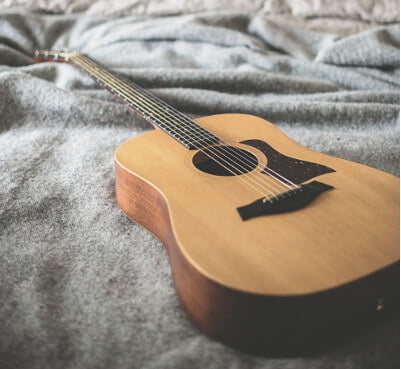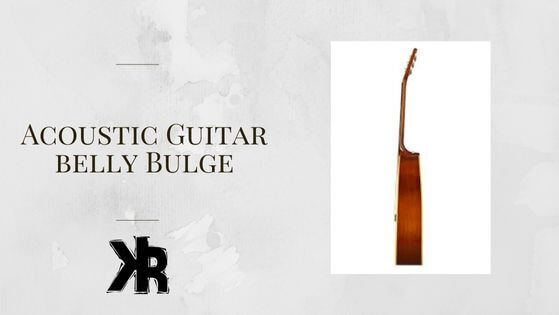Table of Contents
Have you ever noticed that the bridge area of your acoustic guitar sits higher than the rest of the top? This could be an issue. The wooden top, when raised, can create a playability issue. It could almost render the acoustic useless.
The acoustic guitar belly bulge is a raised section of the wood top. This changes the action of your instrument. The tension of the strings can cause this over time. But normally only when environmental conditions are not right.
Some tops are designed to be raised. And so some people mistakenly assume they have a belly bulge on their acoustic. This Killer Rig article will shed some light on what to look for and how to fix it.
What is Acoustic Guitar Belly Bulge?
Every acoustic guitar is designed with bracing to help support the wood parts. This is because once string tension is applied, it can damage the parts over time.
With steel strings, there is nearly 150-200 lbs of tension applied to a guitar. This kind of force will make the guitar want to collapse, and would without proper bracing.
Belly bulge is the result of the wooden top being pulled up at the bridge because of the string tension.
This then causes the strings to move farther from the fretboard. Depending on how it warps or moves, it can also tilt the bridge. This can cause other problems like buzzing or noises.
Causes Of Guitar Belly Bulge
Over time, the force from the strings can begin to warp a guitar in many areas if the environment is not optimal. This can mean dryness or even high heat that affects the wood and adhesive holding the bracing.
Extreme changes in temperature or humidity are normally the issue. The wood can then swell or contract when the guitar is left in these conditions. This can lead to cracks, bulges, and other issues.
One of the most common causes of belly bulge is age. As an acoustic guitar gets older, the adhesive that was used to make the guitar can begin to weaken. With less support, the wooden top can begin to warp and sometimes have the bridge lift.
How To prevent Belly Bulge
The best way to prevent belly bulge is by keeping your acoustic guitar in a case when you’re not playing it. This will ensure that the instrument is not exposed to any drastic changes. Especially changes in temperature or humidity.
Controlling the air in the case with a humidity pack is a great way to prevent belly bulges, among other things.
You should also avoid leaving your guitar in direct sunlight. This can cause the adhesive to heat up and allow movement, shifting, or warping. If you must store it in a sunlit room, make sure to keep the case closed and the temperature on the cool side.
When not playing your acoustic guitar, it’s best to keep it in a controlled environment. That way, you can be sure that the conditions won’t damage the instrument over time.

How To Tell If You Have Acoustic Belly Bulge
Acoustic guitar tops are not normally completely flat by design, as some have an arch. Many have a raised bridge right from the factory as part of the build. This is not bad as the guitar was designed to be this way to set the string height off the fretboard.
If you lay a straight edge across the top of your acoustic, there should be a gap on either side of up to 3/16″.
Some players mistake this with a belly bulge and are fearful that their newer guitar is broken. To tell if your acoustic guitar is affected by this bulge, there are a few things that will be noticeable:
- Tilted or lifted bridge
- Intonation issues
- High action
- Weaker Sound
Sometimes it’s hard to tell if the bridge is tilted. So checking for any space under it will help you realize if it is lifting off the top. You can also check this by trying to put a piece of paper between the bridge and the guitar top.
If it does not go under, then it is not lifting. The most evident will be the high-string action. If you are beginning to find the acoustic guitar is getting hard to play, the bulge should be noticeable.
How To Fix Acoustic Belly Bulge
The best way to fix an acoustic guitar with a belly bulge is to have it repaired by a professional. They will be able to assess the damage and make the necessary repairs.
If you feel you are capable of repairing yourself, there are a couple of ways to remove the bulge.
- Weight and Humidity
- Bridge removal and Belly Reducer
Removing the bridge and clamping a reducer is the preferred method. It’s highly recommended. But others have been successful with simply adding weight. Our concern with this method is that the entire top could be affected and warp.
But with either method, you will want to begin by measuring the bulge with a straight edge. This way you can monitor it as you remove it.
Weight and Humidity
The first way is to place a weight on the guitar top, right on the bulge, or as close as possible. Cover the guitar to protect the finish and add weight like books. You want it to be decently heavy.
You will also want to remove the strings from the acoustic guitar to reduce the tension. This is quite important and so make sure to complete this step.
Once you have weight on the bulge, increase the humidity and temperature in the room and leave it to sit for 24 hours.
Check the bulge by measuring it again with a straight edge after 24 hours. If it has come down substantially, it should be ok. If not, repeat this step.
Bridge Removal and Belly Reducer
This next method is the best way to go about fixing belly bulge and is used by most professionals. You must first begin by removing the bridge. This can be difficult without the right tools, as you do not want to damage the wooden top underneath.
If you do, it might be difficult to re-glue it later. If you do not feel confident in this step, it’s best to see a professional guitar technician.
Once the bridge is removed and the area cleaned, a belly reducer tool set is used to fix the bulge. This includes aluminum bridge plates or cauls and special clamps.
Match the correct plate to the shape of your bridge and clamp them down to the acoustic guitar top. They are to be heated to 150 degrees Fahrenheit beforehand. Then left for 24 hours after being clamped tight.
The force of the clamp and the high heat will straighten the bulge and restore the guitar top to a playable angle. It allows the glue to soften and shift all parts back to where they need to be.
Guitar Belly Bulge Repair Cost
If you have decided to let a professional do the work, this is probably the best decision. While some people can learn how to do it, removing the bridge can be somewhat difficult.
And if any damage is done to the top, it could mean it is forever compromised.
When it comes to the cost to fix an acoustic belly bulge, the range is different among repair shops. You can expect to spend between $200-$400 on average to perform the repair.
This will normally include:
- Removal and re-glue of bridge
- Belly bulge removal
- Basic Set-up
- New strings
JLD Bridge System
Another new product on the market is called the JLD bridge system. It can also help prevent future belly bulging and is highly recommended.
It works so well that all Breedlove guitars are equipped with it right from the factory! This system goes into the body of the acoustic guitar and uses a few screws to fasten through the bridge holes.
Once installed, it uses the body to help reduce the tension of the strings on the bridge and top of the guitar. It’s a very affordable unit and will save on any future repair costs due to this common problem.
Summary
Acoustic guitar belly bulge is a common issue that many players face. It can be caused by different factors. Things such as humidity, string tension, and even the light bracing of the guitar itself.
Yes, you can fix it yourself! But we still recommend that a professional is involved to make sure it gets done without any damage.
FAQs
How much belly bulge is acceptable on an acoustic guitar?
As long as your guitar plays and sounds fine, belly bulge is not a concern. It’s only a problem when the guitar is no longer playable or sounds weak. If you do not have any of the issues we mentioned, then don’t worry about it.
It’s also possible that the arch you are seeing is normal and part of the design. If you are concerned about it, take it to a technician to inspect it and see if you have a belly bulge.
What causes a belly bulge on an acoustic guitar?
Many factors can cause a belly bulge. These include string tension, light bracing, and even humidity. Belly bulges usually form gradually over time. Also, when the conditions are not optimal.
Things like leaving the guitar in a hot car and a dry environment can also cause a belly bulge. It’s best to learn how to properly care for your instrument. Primarily to prevent issues like this from happening. Or, at the very least, prolong them.

